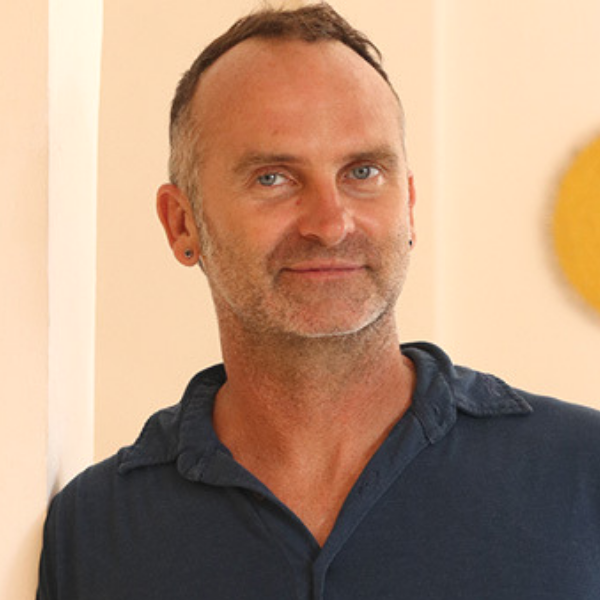24 Apr The 3 Sacred Rivers : Ayurveda-Yoga-Tantra

Coming to Power Living soon is Brad Hay, Ayurvedic Specialist and Senior ParaYoga Teacher. He brings a wealth of knowledge gathered over 20 years of teaching, studying under some of the most renowned teachers and being mentored by Master Teacher, Yogarupa Rod Stryker. Here, he outlines the topics which will be the subject of his workshops, so you better understand how they fit together and apply to you as a modern-day yoga student.
Vedic wisdom is the most ancient, profound, sophisticated, embodied knowledge known to humankind. Many scholars of our modern time have done their best to date these scriptures and say their origins date back between 1500 BCE and 12,000 BCE. That’s a big variation in time! And as much as history is fascinating and holds its own value, I believe the most important aspects are the timeless teachings themselves.
These teachings are streams of consciousness and, while most of the wisdom and mythology is based in ancient India and of course the Great Himalayan Mountains, the wisdom is relevant to all humans and nature on all of planet Earth.
The origins of Ayurveda, Yoga, and Tantra all come from the ancient Vedic wisdom traditions. These three systems combined create the world’s most sophisticated, comprehensive, holistic approach to health, longevity, happiness and ultimately freedom.
I will begin with an overview of each of these systems and then we will begin to see they are in complete support of one another in the progression of human evolution. In my perspective, these systems are incomplete without one another!
Ayurveda
Ayurvedic medicine is commonly known as, “The Science of Life & Longevity”, or as I like to call it, “The Divine Code of Nature”. It is also often referred to as “Yoga’s Sister Science” and, as we study more, we’ll begin to see why. Ayurveda has its roots deeply set in Sankhya Philosophy. The focus of Ayurveda is preparing the body to be the greatest possible vessel of light.
Ayurveda is a vast field of practices, principles, and philosophy targeted at how to live a life most harmoniously within our own unique constitutional blueprint (prakruti) and in alignment with the rhythms of nature and the universe. Ayurveda’s role is basically to keep mankind healthy while he/she realizes their true potential or state of Yoga (union with the divine). Not to mention to enjoy a vibrant, healthy and happy life along the way!
While there are definitely aspects of spirituality in Ayurveda, its main emphasis is to both purify and strengthen the body and immune system in preparation for more powerful and refined work with the subtle energy of body and mind. Basically, meaning Yoga and Tantra.
The two main goals of Ayurveda are:
- To keep the body in a state of optimal health and free from disease
- To show us how to use health as a basis of, or part of the path to enlightenment.
Ayurveda has a strong emphasis on preventative medicine and believes that one of the most powerful ways to gain and sustain optimal health is by creating healthy daily routines to keep your system as in balance as possible. These routines can include purification practices like nasal cleansing (netti pot), tongue scraping, proper diet and eating practices (sadhana), herbal treatments, optimal sleep rhythms, management of the senses and sexual energies, yogic practices attitudes and psychology, self-care practices, and much more.
Traditional Yoga
The Sanskrit noun yoga translates to (and is associated with) English “yoke”. It is derived from the root yuj “to attach, join, harness, yoke”. This union or yoking is the union of individual soul (Atman) with Universal soul (Purusha). Yoga, according to the great text The Bhagavad Gita, is “Skill in Action”. The focus of Traditional Yoga (Patanjali) is the Mind.
There’s a multitude of Yoga schools and, in our modern day, styles and brands that have been formulated over the years. Some are traditional, and many are not. Some schools were developed from enlightened beings, seers and rishis, and some were definitely not. The foundation of traditional Yoga also has its roots in Sankhya Philosophy.
The four traditional schools of Yoga
- Jnana Yoga: The path of knowledge
- Bhakti Yoga: The path of love and devotion
- Karma Yoga: The path of action
- Raja Yoga: The royal path. Meditation, Patanjali, 8 limbs etc.
In this instance, we will talk about Raja Yoga which includes Patanjali Yoga, the Yoga Sutras, and the traditional 8 rungs of Ashtanga. Yoga is primarily a system of perception and awareness through the vehicle of meditation and contemplation. It discusses in-depth how to understand and overcome the obstacles of the mind.
It is also a system that focuses on both viyoga and samyoga.
Viyoga literally means “separation.” Viyoga refers to the process of separating ourselves from whatever is undesirable in our lives. As an eliminative process, it involves the purification of both mind and body. It also involves letting go of unhealthy attachments, giving up self-destructive behaviour, and breaking detrimental relationships. This is accomplished by working within the five inner spheres, utilizing specific methods to mitigate distortions of mood, thought, and behaviour; balance sympathetic/parasympathetic function; and reduce or eliminate musculoskeletal or neuromuscular stress.
Samyoga literally means “linking together.” Samyoga refers to the process of connecting to whatever is positive and productive in our lives. It involves the development of mental qualities such as kindness, courage, patience, compassion, self-restraint, endurance, one-pointedness, and tranquillity. It also involves establishing appropriate priorities, practising virtues, and cultivating positive relationships.
Tantric Yoga
Tantra (Sanskrit: तन्त्र) literally means “loom, warp, weave”. Other translations of the word tantra are to stretch beyond limits, systems, and methodology, just to name a few. The focus of Tantra is the masterful use of energy.
The connotation of the word tantra means an esoteric practice or religious ritualism. The Sanskrit root ‘tan’ means the warping of threads on a loom. It implies “interweaving of traditions and teachings as threads” into a text, technique or practice.
Tantra is the most comprehensive school of Yoga and includes all systems and techniques of Yoga. It is a world-view/philosophy AND a science to help you embody the philosophy. Hatha Yoga techniques including, asana, bandha, and kriya come from the Tantric Hatha Yoga School. Tantra sees the body as a means to liberation and enlightenment rather than an obstacle as other schools of Yoga see it.
The Gherhand Samhita which accompanies the great and one of the most treasured Tantric Hatha Yoga texts, The Hatha Yoga Pradipika, lays out a 7-fold path:
- Shatkarma for body cleansing/purification
- Asana for body strengthening
- Mudra for body steadying
- Pratyahara for mind-calming
- Pranayama for inner lightness
- Dhyana for inner perception
- Samadhi for self-liberation and bliss
An overview of each three systems and their focus:
| System | Field | Emphasis |
| Ayurveda | Body | Purification, Digestion, Rejuvenation, Sensory management, Immunity-Ojas, strengthening, Medicine |
| Yoga | Mind | Vedic Psychology & Philosophy, Contemplation, Concentration, Meditation, Self-Enquiry |
| Tantra | Energy | Mastery of Prana, Hatha Yoga Techniques, Kriya, Meditation, Mantra, Shakti, Ritual |



